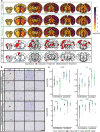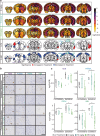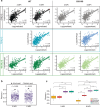LRRK2 kinase inhibition reverses G2019S mutation-dependent effects on tau pathology progression
- PMID: 38438877
- PMCID: PMC10910783
- DOI: 10.1186/s40035-024-00403-2
LRRK2 kinase inhibition reverses G2019S mutation-dependent effects on tau pathology progression
Abstract
Background: Mutations in leucine-rich repeat kinase 2 (LRRK2) are the most common cause of familial Parkinson's disease (PD). These mutations elevate the LRRK2 kinase activity, making LRRK2 kinase inhibitors an attractive therapeutic. LRRK2 kinase activity has been consistently linked to specific cell signaling pathways, mostly related to organelle trafficking and homeostasis, but its relationship to PD pathogenesis has been more difficult to define. LRRK2-PD patients consistently present with loss of dopaminergic neurons in the substantia nigra but show variable development of Lewy body or tau tangle pathology. Animal models carrying LRRK2 mutations do not develop robust PD-related phenotypes spontaneously, hampering the assessment of the efficacy of LRRK2 inhibitors against disease processes. We hypothesized that mutations in LRRK2 may not be directly related to a single disease pathway, but instead may elevate the susceptibility to multiple disease processes, depending on the disease trigger. To test this hypothesis, we have previously evaluated progression of α-synuclein and tau pathologies following injection of proteopathic seeds. We demonstrated that transgenic mice overexpressing mutant LRRK2 show alterations in the brain-wide progression of pathology, especially at older ages.
Methods: Here, we assess tau pathology progression in relation to long-term LRRK2 kinase inhibition. Wild-type or LRRK2G2019S knock-in mice were injected with tau fibrils and treated with control diet or diet containing LRRK2 kinase inhibitor MLi-2 targeting the IC50 or IC90 of LRRK2 for 3-6 months. Mice were evaluated for tau pathology by brain-wide quantitative pathology in 844 brain regions and subsequent linear diffusion modeling of progression.
Results: Consistent with our previous work, we found systemic alterations in the progression of tau pathology in LRRK2G2019S mice, which were most pronounced at 6 months. Importantly, LRRK2 kinase inhibition reversed these effects in LRRK2G2019S mice, but had minimal effect in wild-type mice, suggesting that LRRK2 kinase inhibition is likely to reverse specific disease processes in G2019S mutation carriers. Additional work may be necessary to determine the potential effect in non-carriers.
Conclusions: This work supports a protective role of LRRK2 kinase inhibition in G2019S carriers and provides a rational workflow for systematic evaluation of brain-wide phenotypes in therapeutic development.
Keywords: Cell-to-cell spread; G2019S; Genetic risk; MLi-2; Mapt; Transmission.
© 2024. The Author(s).
Conflict of interest statement
C.E.G.L. and M.J.F. are salaried employees of Merck Sharp & Dohme LLC, a subsidiary of Merck & Co., Inc., Rahway, NJ, USA.
Figures








Similar articles
-
Widespread distribution of α-synuclein oligomers in LRRK2-related Parkinson's disease.Acta Neuropathol. 2025 May 2;149(1):42. doi: 10.1007/s00401-025-02872-9. Acta Neuropathol. 2025. PMID: 40314842 Free PMC article.
-
Astrocytes carrying LRRK2 G2019S exhibit increased levels of clusterin chaperone via miR-22-5p and reduced ability to take up α-synuclein fibrils.Acta Neuropathol Commun. 2025 May 12;13(1):98. doi: 10.1186/s40478-025-02015-x. Acta Neuropathol Commun. 2025. PMID: 40355981 Free PMC article.
-
LRRK2 kinase inhibition protects against Parkinson's disease-associated environmental toxicants.Neurobiol Dis. 2024 Jun 15;196:106522. doi: 10.1016/j.nbd.2024.106522. Epub 2024 May 3. Neurobiol Dis. 2024. PMID: 38705492 Free PMC article.
-
The Black Book of Psychotropic Dosing and Monitoring.Psychopharmacol Bull. 2024 Jul 8;54(3):8-59. Psychopharmacol Bull. 2024. PMID: 38993656 Free PMC article. Review.
-
LRRK2-mediated mitochondrial dysfunction in Parkinson's disease.Biochem J. 2025 May 28;482(11):721-39. doi: 10.1042/BCJ20253062. Biochem J. 2025. PMID: 40440058 Free PMC article. Review.
Cited by
-
Dopamine and cortical neurons with different Parkinsonian mutations show variation in lysosomal and mitochondrial dysfunction.NPJ Parkinsons Dis. 2025 Jun 20;11(1):177. doi: 10.1038/s41531-025-01048-2. NPJ Parkinsons Dis. 2025. PMID: 40541941 Free PMC article.
-
Role of LRRK2 in axonal transport and Parkinson's disease.Biochem J. 2025 Jun 25;482(13):905-19. doi: 10.1042/BCJ20253133. Biochem J. 2025. PMID: 40570189 Free PMC article. Review.
-
LRRK2 kinase activity restricts NRF2-dependent mitochondrial protection in microglia.bioRxiv [Preprint]. 2024 Jul 13:2024.07.09.602769. doi: 10.1101/2024.07.09.602769. bioRxiv. 2024. PMID: 39026883 Free PMC article. Preprint.
-
Network analysis of α-synuclein pathology progression reveals p21-activated kinases as regulators of vulnerability.bioRxiv [Preprint]. 2024 Oct 22:2024.10.22.619411. doi: 10.1101/2024.10.22.619411. bioRxiv. 2024. PMID: 39484617 Free PMC article. Preprint.
-
Recent advances in targeting LRRK2 for Parkinson's disease treatment.J Transl Med. 2025 Jul 8;23(1):754. doi: 10.1186/s12967-025-06354-0. J Transl Med. 2025. PMID: 40629324 Free PMC article. Review.
References
Publication types
MeSH terms
Substances
Grants and funding
LinkOut - more resources
Full Text Sources

